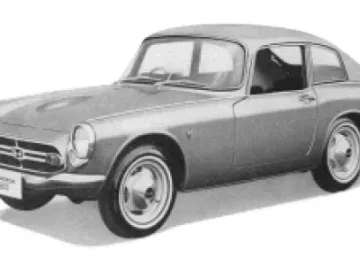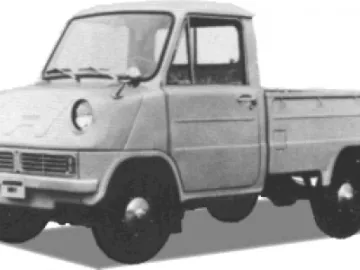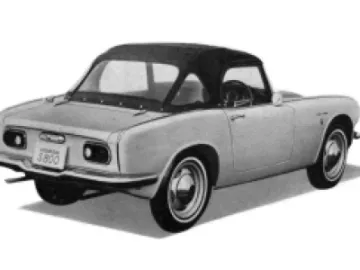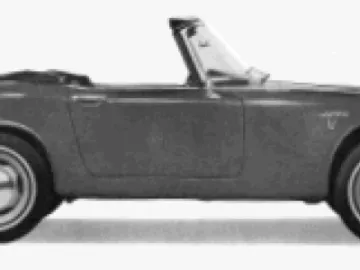History of the S type

The Honda S800 was not a 'One Off' exercise on the part of Honda. It started with Hondas intention to create a small 360 cc car which was intended to suit the Japanese home market and the tax incentives given to owners of small cars with limited engine capacity. Mr Honda put together a team of young engineers whose eldest member was only 28 years old. The brief for the project was to produce a car with "sports appeal", something normally missing in this tax free sector. It should also give a taste of what a competition vehicle was like and must also be a vehicle that they would like to own themselves.

By mid 1962 the team had managed to put together a small two seater sports car, utilising an engine similar to the Honda T360 commercial truck. Visually the car had similar lines to the S800 that we know but with slightly more compact dimensions measuring in at 2990mm long, 1295mm wide and 1146mm high. The engine only had a 356cc capacity and developed 33 BHP at 9000 rpm!. The engine was a tiny jewel of a 4 cylinder with twin cams, a roller bearing crankshaft and two twin-choke carburettors. The mechanical parts were fitted into a neat ladder chassis. The final drive incorporated a rear axle positioned just behind the drivers seat. From the ends of the axle two independently sprung chain cases took up the final drive to the wheels and these also acted as trailing arms giving an independent rear suspension layout.

The S360 was produced in prototype form only and did not make it to production. It was thought that the potential of the car was compromised by the limitation of the tax class to 360cc vehicles.The natural progression from the S360 was of course to make the car more powerful and along came the S500 (although this model was not exported from Japan). The capacity was now 531 cc which developed 44 BHP, again with the similar engine configuration as the S360 and independent suspension and drum brakes. All the models so far were in convertible form only, it wasn't until 1964 and the S600 that the option of a 'Fixed Head' Coupe (FHC) became available.
The S600 was introduced in March 1964 and with 57 BHP had quite a power advantage over the S500. The production increased to an output of 5210 cars in 1964, rising to 8779 cars in 1965. Up to this point the car was still aimed at the home market, but it wasn't long before the S600 started to appear in Australia and at least two racing versions of the S600 appeared in the U.K. for promotional purposes.

All the markets up to now were R.H. drive, but by late 1965 L.H. drive cars were starting to appear throughout Europe, notably those countries with taxation advantages for small capacity engines. A number of S600's also found their way into the United States often personally imported by members of the Armed Services returning home.
Although the S600 was not marketed in the U.K. six cars did find their way here. In early 1966 Honda undertook further development of the 'S' type which involved the engine capacity being raised again to 791 cc and the model name being revised to the S800. This model initially retained the drum brakes and chain drive independent rear suspension of the S600.
In October 1966 two coupes and a convertible arrived at King George V Docks, London. The S800 had arrived in the U.K.
The convertible (LYY 832D) was put on show at the 1966 Earls Court motor show and is now owned by a club member. The Coupes were owned by a Midlands based dealer and registered HON 1D and HON 800D. A total of only six S800's came to the U.K. during 1966, and it wasn't until 1967 that the S800 was imported into the UK in any numbers.
It appears that the chain drive S800 was a very rare beast indeed, it was expensive to produce and so a decision was made to rationalise the S800 with a live rear axle. Undoubtedly, we all appreciate that the Honda S800 cannot have been easy or inexpensive to produce, so to stay competitive with rival sports cars in the export markets, economies had to be made. So when the major thrust of S800's arrived in 1967, the cars had the now familiar specification of a live rear axle, front disc brakes and 70 BHP, (at a heady 8000 RPM), to meet the Spitfires, Healey's and Midgets head on.
There were, however, big problems for Honda in the U.S.A., where traditionally the British sports cars had made inroads into the market. The rapid development of the Mk2 S800 (as we know it) or more correctly the S800M was a direct response to the American safety legislation; hence the recessed door handles, side marker lights, hazard warning lights, and dual circuit brakes. All this effort had one major drawback – the engine! Despite its sophistication and the ability to produce high amounts of power from a small cubic capacity, the US decided its output was considered "dirty" in environmental terms, with a high percentage of unburned hydrocarbons*. An amazing decision when you consider the small capacity of the car (0.79 litres) compared to the 5 and 7 litre gas guzzlers of the time in the US, but I guess there were some protectionist considerations at work.

The loss of the all important U.S. market led to the S800 being discontinued. The annual production figures showed that the S800 never met the output of the S600, yet the S800 was intended for world exports.
Production tailed off in 1969 with final U.K. sales carrying on into 1970. Honda demonstrated its ability to adapt and change and went away to develop the clean burning CVCC engine which gave Honda its worldwide success – the Civic – its name. The S800, however, is a true landmark model – the first car from Honda – and a clear demonstration that the engineers ruled the roost at that time and not the accountants. It was a car like no other. Outwardly it was similar in size to the MG Midget but there the similarity ended. Whilst the MG made do with a wheezy "A" series lump which ran out of breath at 5500 revs, our Hondas are only just getting on song at that engine speed. The redline starts at 8500 rpm and extends to 11000 rpm!!. Some fifty years on the specification still amazes the uninitiated – we can only guess what the reaction to this engineering marvel was like when it first appeared.
* A recent test of a well tuned and maintained S800 revealed that it would in fact be capable of passing the exhaust emissions element of the UK Dept. of Transport Test or MOT for post 1986 produced cars!, despite its engine having been designed some 20 years earlier.
